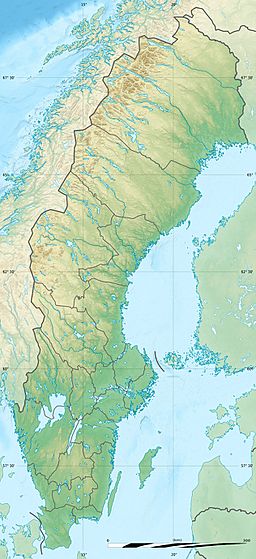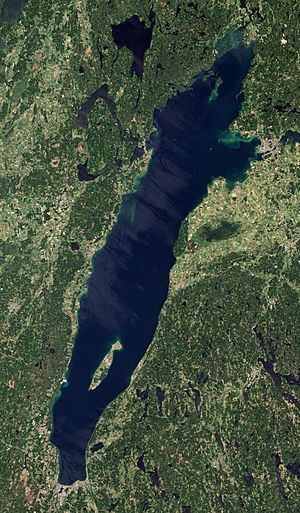Vättern facts for kids
Quick facts for kids Vättern |
|
|---|---|

West to east view of the lake including Visingsö in the foreground
|
|
| Coordinates | 58°24′N 14°36′E / 58.400°N 14.600°E |
| Primary outflows | Motala ström |
| Catchment area | 4,503 km2 (1,739 sq mi) |
| Basin countries | Sweden |
| Surface area | 1,912 km2 (738 sq mi) |
| Average depth | 41 m (135 ft) |
| Max. depth | 128 m (420 ft) |
| Water volume | 77.0 km3 (18.5 cu mi) |
| Surface elevation | 88 m (289 ft) |
| Islands | Visingsö |
| Settlements | Vadstena, Jönköping, Hjo, Askersund, Åmmeberg, Karlsborg, Motala |
Lake Vättern (pronounced VET-ərn) is a very important lake in Sweden. It is the second largest lake in Sweden by how much surface it covers. Only Lake Vänern is bigger. It's also the sixth largest lake in all of Europe!
Vättern is a long, narrow lake shaped like a finger. It's located in south-central Sweden. Even though it's smaller than Vänern in surface area, it holds about half as much water. This is because Vättern is a very deep lake. Its deepest point is 128 m (420 ft) (about 420 feet) below the surface.
The lake's water flows out into a river called Motala ström. This river eventually reaches the Baltic Sea. Since 1832, Vättern has also been connected to Lake Vänern by the Göta Canal. This canal allows boats to travel from Vättern all the way to the Atlantic Ocean. Many smaller rivers and lakes feed water into Vättern.
Contents
What Does the Name Vättern Mean?
The name Vättern is very old and simple. It is closely related to the Swedish word "vatten," which means "water." So, Vättern basically means "the water" or "the lake."
Where is Lake Vättern Located?
Lake Vättern covers a huge area of about 1,912 km2 (738 sq mi) (about 738 square miles). The land area that drains water into the lake is even bigger, around 4,503 km2 (1,739 sq mi) (about 1,739 square miles). The deepest part of the lake is south of Visingsö island, reaching 128 m (420 ft) deep. On average, the lake is about 41 m (135 ft) deep. The shoreline around the lake is about 642 km (399 mi) long. The lake holds a massive 77.0 km3 (18.5 cu mi) of water. The water level of the lake is carefully controlled.
Vättern is located in a region of Sweden called Götaland. The main river that carries water out of the lake is Motala ström, which starts in the town of Motala. This river eventually flows into the Baltic Sea.
Cities and Islands Around Vättern
A beautiful island called Visingsö is located in the lake, near the town of Gränna. Many towns are built along the shores of Vättern, including Vadstena, Jönköping, Hjo, Askersund, Åmmeberg, and Karlsborg. The lake borders four different Swedish provinces: Västergötland, Närke, Östergötland, and Småland.
In the northern part of the lake, there's a lovely inland fjord called Alsen. A fjord is a long, narrow inlet of the sea, but this one is inland. Most of the land around Vättern (about 62%) is covered by forests. These forests have trees like spruce, pine, and other trees that lose their leaves. About 26.7% of the land is used for farming.
How Lake Vättern Was Formed
Lake Vättern has a very old and interesting history. While many smaller lakes in southern Sweden were formed by glaciers scraping away the land, Vättern was created differently. It formed about 700 to 800 million years ago because of powerful movements in the Earth's crust. It's a type of valley called a graben, which forms when a block of land sinks down between two faults.
Glaciers and the Lake's History
Over millions of years, huge sheets of ice called glaciers covered the lake and the land around it many times. As these glaciers moved and then melted away, they left marks on the rocks and shaped the landscape.
The lake we see today started to form about 10,000 years ago. This was after the last big ice age, when the giant Scandinavian glacier melted. At first, Vättern was a small bay of a much larger ancient lake called the Baltic ice lake. Later, it became connected to other ancient water bodies like the Yoldia Sea and then Ancylus Lake.
Around 8,000 years ago, the land in Scandinavia started to rise unevenly. This caused Vättern to become separate from Ancylus Lake. Many of the unique animals that live in Vättern today, like the Arctic char, are "relict species." This means they are leftovers from the time when the lake was connected to colder, ancient waters.
Today, the land around Vättern is still slowly rising. It's rising about 3.5 mm (0.14 in) per year in the northeast and 2.6 mm (0.10 in) per year in the south. This means that Vättern is actually tilting slightly to the south by about 1 mm (0.039 in) each year!
Animals and Plants in Lake Vättern
Lake Vättern is home to many different kinds of living things. It has tiny floating organisms called phytoplankton (like tiny plants) and zooplankton (like tiny animals). These include small creatures like Copepoda and Cladocera.
Life on the Lakebed
On the bottom of the lake, in the benthos, you can find creatures like Crustacea (like tiny shrimp), Oligochaeta (like worms), Diptera (insect larvae), and Bivalvia (like clams).
Fish Species
Vättern is also home to several types of fish. These include Salvelinus salvelinus (a type of char), Coregonus lavaretus (whitefish), and Salmo salar (Atlantic salmon). The lake is especially famous for its Vättern char, which is a type of Arctic char (Salvelinus alpinus). This Vättern char is very similar to the char found in nearby Lake Sommen and even in Lake Ladoga in Russia.
How People Use Lake Vättern
The Lake's Amazing Water Quality
Vättern is well-known for its incredibly clear and clean water. Many towns around the lake get their drinking water directly from Vättern. The water is so clean that it needs very little treatment before it's pumped into homes. You can even safely drink the natural, untreated water from almost anywhere in the lake! Some people believe Vättern might be the largest source of drinkable water in the entire world. All the towns around the lake also make sure to clean 100% of their wastewater before it goes back into the environment.
Fun Activities on the Lake
Vättern is famous for an annual bike race called Vätternrundan. About 20,000 people come to ride their bikes around the lake, covering a distance of 300 kilometers (about 186 miles).
The lake is also a great place for fishing. People who live nearby enjoy fishing in Vättern. Tourists and vacationers can also fish in the lake for fun, as long as they don't use nets. There is also some commercial fishing that takes place.
Industries Around the Lake
The area around Lake Vättern has several important industries. These include mining, manufacturing (making goods), forestry (working with trees), and paper production. Farmers in the area also raise animals like cattle, sheep, pigs, and chickens.
See also
 In Spanish: Lago Vättern para niños
In Spanish: Lago Vättern para niños



